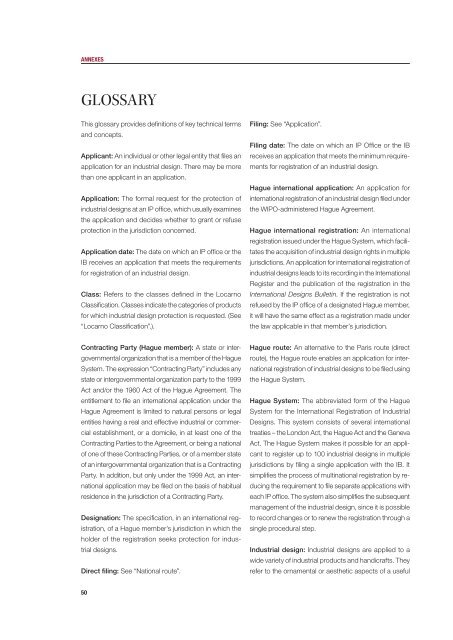wEyG1
wEyG1
wEyG1
You also want an ePaper? Increase the reach of your titles
YUMPU automatically turns print PDFs into web optimized ePapers that Google loves.
ANNEXES<br />
GLOSSARY<br />
This glossary provides definitions of key technical terms<br />
and concepts.<br />
Applicant: An individual or other legal entity that files an<br />
application for an industrial design. There may be more<br />
than one applicant in an application.<br />
Application: The formal request for the protection of<br />
industrial designs at an IP office, which usually examines<br />
the application and decides whether to grant or refuse<br />
protection in the jurisdiction concerned.<br />
Application date: The date on which an IP office or the<br />
IB receives an application that meets the requirements<br />
for registration of an industrial design.<br />
Class: Refers to the classes defined in the Locarno<br />
Classification. Classes indicate the categories of products<br />
for which industrial design protection is requested. (See<br />
“Locarno Classification”.).<br />
Filing: See “Application”.<br />
Filing date: The date on which an IP Office or the IB<br />
receives an application that meets the minimum requirements<br />
for registration of an industrial design.<br />
Hague international application: An application for<br />
international registration of an industrial design filed under<br />
the WIPO-administered Hague Agreement.<br />
Hague international registration: An international<br />
registration issued under the Hague System, which facilitates<br />
the acquisition of industrial design rights in multiple<br />
jurisdictions. An application for international registration of<br />
industrial designs leads to its recording in the International<br />
Register and the publication of the registration in the<br />
International Designs Bulletin. If the registration is not<br />
refused by the IP office of a designated Hague member,<br />
it will have the same effect as a registration made under<br />
the law applicable in that member’s jurisdiction.<br />
Contracting Party (Hague member): A state or intergovernmental<br />
organization that is a member of the Hague<br />
System. The expression “Contracting Party” includes any<br />
state or intergovernmental organization party to the 1999<br />
Act and/or the 1960 Act of the Hague Agreement. The<br />
entitlement to file an international application under the<br />
Hague Agreement is limited to natural persons or legal<br />
entities having a real and effective industrial or commercial<br />
establishment, or a domicile, in at least one of the<br />
Contracting Parties to the Agreement, or being a national<br />
of one of these Contracting Parties, or of a member state<br />
of an intergovernmental organization that is a Contracting<br />
Party. In addition, but only under the 1999 Act, an international<br />
application may be filed on the basis of habitual<br />
residence in the jurisdiction of a Contracting Party.<br />
Designation: The specification, in an international registration,<br />
of a Hague member’s jurisdiction in which the<br />
holder of the registration seeks protection for industrial<br />
designs.<br />
Direct filing: See “National route”.<br />
Hague route: An alternative to the Paris route (direct<br />
route), the Hague route enables an application for international<br />
registration of industrial designs to be filed using<br />
the Hague System.<br />
Hague System: The abbreviated form of the Hague<br />
System for the International Registration of Industrial<br />
Designs. This system consists of several international<br />
treaties – the London Act, the Hague Act and the Geneva<br />
Act. The Hague System makes it possible for an applicant<br />
to register up to 100 industrial designs in multiple<br />
jurisdictions by filing a single application with the IB. It<br />
simplifies the process of multinational registration by reducing<br />
the requirement to file separate applications with<br />
each IP office. The system also simplifies the subsequent<br />
management of the industrial design, since it is possible<br />
to record changes or to renew the registration through a<br />
single procedural step.<br />
Industrial design: Industrial designs are applied to a<br />
wide variety of industrial products and handicrafts. They<br />
refer to the ornamental or aesthetic aspects of a useful<br />
50


